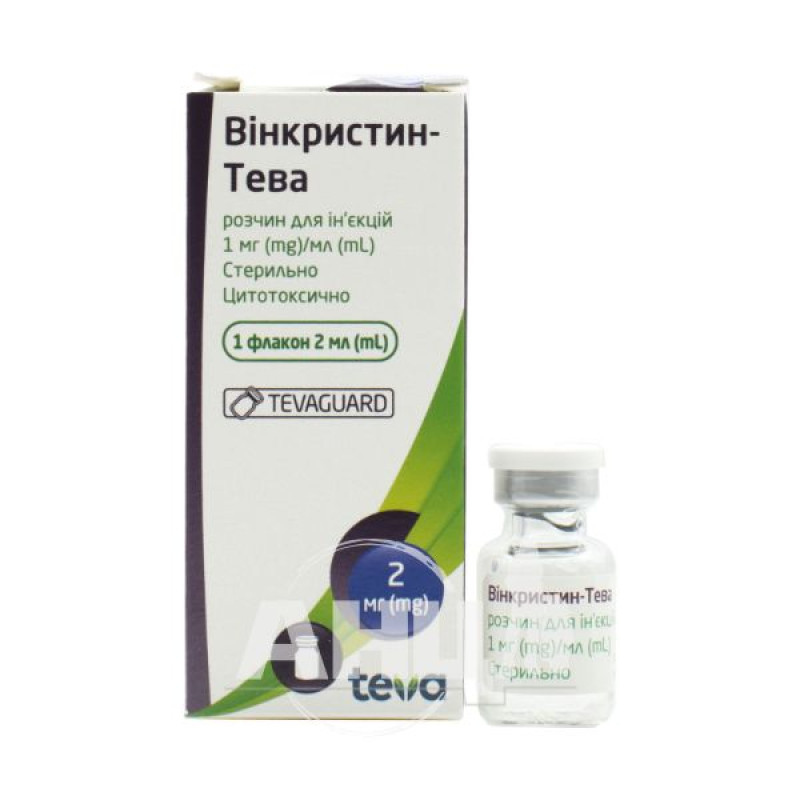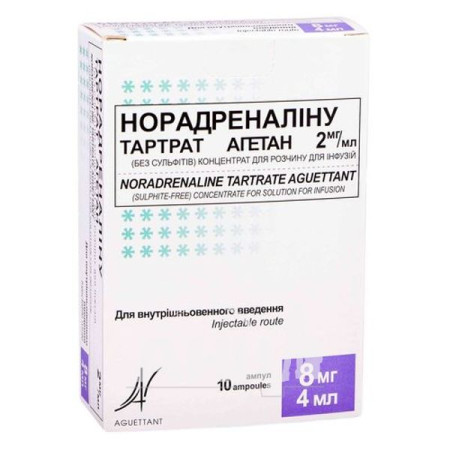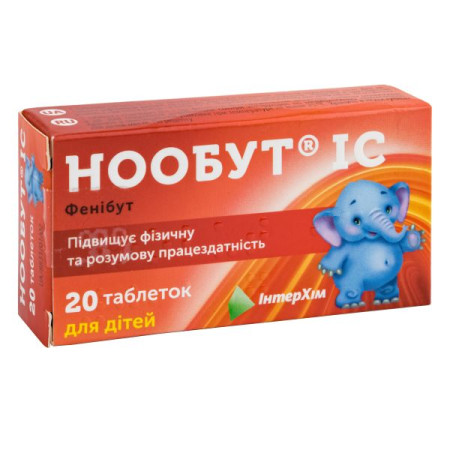Vincristine-Teva solution for injection 1 mg/ml vial 2 ml No. 1

Pharmacological properties
An antitumor drug, an alkaloid obtained from periwinkle (vinca rosea L.). The antiblastoma and cytotoxic effects of vincristine are due to disruption of microtubule and mitotic spindle formation, as well as disruption of DNA and RNA synthesis in cells.
After 15-30 minutes after IV administration, more than 90% of the drug is redistributed from the blood into the tissues, with which it binds strongly but reversibly. The drug penetrates poorly through the blood-brain barrier. The kinetics of the drug after jet IV administration are triphasic. The half-life in the first and second phases is 5 minutes and 2.3 hours, respectively; the duration of the half-life in the terminal phase is subject to significant fluctuations (from 19 to 155 hours), averaging 85 hours. The drug is excreted mainly with feces (about 80%), a smaller part - with urine (10-20%). The pharmacokinetics of vincristine in case of impaired liver function may change.
Indication
Acute leukemias, lymphogranulomatosis, non-Hodgkin lymphomas, reticulosarcoma, lymphosarcoma, rhabdomyosarcoma, neuroblastoma, Wilms' tumor.
Application
Vincristine is administered only intravenously. Ampouled vincristine solution can be further diluted with water for injection or isotonic sodium chloride solution. Extravasation of the drug should be avoided during administration. The drug is administered at intervals of 1 week. Adults are usually prescribed at the rate of 1.4 mg per 1 m2 of body surface, the maximum dose is 2 mg / m2. For leukemia, it is prescribed at a dose of 0.025-0.075 mg / kg 1 time per week. In the treatment of other malignant tumors, the recommended dose is 0.025 mg / kg 1 time per week. For maintenance therapy, the drug can be administered weekly at a dose of 0.005-0.01 mg / kg. Vincristine can be used in combination with other anticancer drugs.
Children are prescribed at the rate of 2 mg per 1 m2 of body surface. The dose of the drug for infants is calculated taking into account body weight: for induction of remission in acute leukemia, a dose of 0.05-0.15 mg/kg is prescribed once a week. For acute leukemia in children, the following regimen is used: the first dose is 0.05 mg/kg, the second dose is 0.075 mg/kg, the third dose is 0.1 mg/kg, the fourth dose is 0.125 mg/kg. The maximum dose is 0.15 mg/kg once a week. After achieving remission, the drug is prescribed in a maintenance dose of 0.05-0.075 mg/kg once a week.
In patients with serum bilirubin levels above 0.03 mg/ml, the dose of vincristine is halved. Vincristine is not prescribed to patients receiving radiotherapy to the liver.
When combining vincristine with L-asparaginase, it is administered 12-24 hours before the enzyme; administration of L-asparaginase before vincristine may reduce its biliary elimination.
Contraindication
Hypersensitivity to the drug, diseases of the central nervous system and peripheral nerves.
Side effects
Possible headache, neuropathy, peripheral neuritis, sensory disturbances, cranial nerve damage, transient blindness and optic nerve atrophy, gait disturbance, loss of deep tendon reflexes, muscle weakness, cramps, pain in the jaw, pharynx, parotid glands, bones, back, spine and muscles; anemia, leukopenia, thrombocytopenia (less pronounced than with the use of other antineoplastic agents); constipation, intestinal spasms, weight loss, anorexia, nausea, vomiting, aphthous stomatitis, diarrhea, paralytic ileus, necrosis of the small intestine and / or its perforation; decreased heart rate, angina pectoris and myocardial infarction (in patients with previously irradiated mediastinum), polyuria, dysuria and urinary retention due to bladder atony, allergic reactions (rash, angioedema, anaphylactic shock), shortness of breath, bronchospasm, fever, alopecia, rarely - syndrome due to impaired secretion of antidiuretic hormone (hyponatremia due to increased sodium excretion in the urine), azoospermia, menstrual disorders.
Special instructions
Treatment with the drug can only be carried out by an experienced chemotherapist in a specialized hospital. Vincristine is administered only intravenously; Endolumbar administration is strictly contraindicated (can be fatal).
Extravasation may cause soft tissue necrosis; to prevent this, it is recommended to cauterize the extravasated area with hyaluronidase or hydrocortisone at a dose of 20-25 mg, and apply warming compresses to the affected area. Vincristine is prescribed with caution in the early postoperative period, since a significant part of the intravenously administered drug can enter the postoperative wound, causing edema, inflammation, and local tissue necrosis.
To prevent constipation during treatment with the drug, appropriate treatment is prescribed (cleansing enemas, laxatives). Some patients (especially children) may develop paralytic ileus during treatment with vincristine, which in some cases is masked by the symptoms of an acute abdomen; it usually disappears when vincristine is discontinued and symptomatic treatment is carried out.
The neuro- and hepatotoxic effects of the drug are more pronounced in infants.
During treatment, patients should have regular examinations of the fundus and visual fields; at the slightest suspicion of optic nerve damage, treatment is discontinued. Any complaint of eye pain or decreased visual acuity requires a thorough ophthalmological examination.
To reduce the degree of alopecia during chemotherapy, local hypothermia of the scalp or the application of a tourniquet (pressure helmet) can be used. Pressure on the scalp is not applied in leukemia and lymphomas, as well as in the presence of metastases or infiltrates on the scalp.
If leukopenia develops, further treatment with the drug should be approached with caution.
Dyspnea and bronchospasm occur most frequently when the drug is combined with mitomycin-C and may require intensive treatment, especially in the presence of baseline respiratory failure. These reactions may occur within minutes to hours after the administration of vincristine and within 2 weeks after the administration of mitomycin. Progressive dyspnea requires discontinuation of vincristine therapy.
Before each administration of vincristine, peripheral blood composition should be examined. During the induction of remission in the treatment of acute leukemia, the level of uric acid in the blood may increase; this indicator should be monitored during the first 3-4 weeks of treatment and appropriate measures should be taken to prevent neuropathy caused by uric acid diathesis. Laboratory tests are repeated until the indicator normalizes. During treatment with vincristine, the concentration of sodium ions in the blood serum is periodically determined. Hyponatremia develops due to impaired secretion of antidiuretic hormone and should be corrected by the introduction of physiological sodium chloride solution.
During treatment with vincristine, systematic ECG monitoring should be carried out. In the process of treating children with malignant tumors, monitoring of their intellectual, emotional state, speech and neurophysiological status is necessary.
Medical personnel must wear protective clothing (gloves, gown), as well as goggles and a mask when working with the drug. Pregnant women are not allowed to work with the drug. If the drug gets into the eyes, they must be washed with plenty of water or saline.
Interactions
Intravenous administration of phenytoin or its ingestion during treatment with vincristine reduces the anticonvulsant activity of the drug and may cause an increase in the number of epileptic seizures. The neurotoxicity of isoniazid is enhanced when combined with other neurotoxic drugs (asparaginase, isoniazid, etc.). Vincristine may increase the level of uric acid in the blood and reduce the effectiveness of antigout drugs. Simultaneous use of vincristine with other myelodepressive drugs (doxorubicin in combination with prednisolone, etc.) may enhance the myelotoxic effect of the drug. When vincristine is combined with mitomycin-C, acute respiratory disorders may occur (see above). Vincristine may reduce the effectiveness of vaccination when using vaccines from live and inactivated viruses and increase the frequency of side effects of live virus vaccines. Regional radiotherapy may enhance the peripheral neurotoxicity of vincristine.
Overdose
In children under 13 years of age, a tenfold excess of the drug dose can lead to death. Administration of the drug to children under 13 years of age at a dose of 3-4 mg/m2, and to adults - a single dose of 3 mg/m2 and more can cause a serious general condition of the patient. There is no specific antidote. Symptomatic and supportive treatment is carried out under the control of water-salt balance, ECG, and peripheral blood composition. In the event of the development of generalized convulsive seizures, anticonvulsants are used. If necessary, blood transfusions, transfusions of erythrocyte and platelet mass are performed. Calcium folinate is administered intravenously at a dose of 100 mg every 3 hours for 24 hours, and then every 6 hours for at least 48 hours. Hemodialysis is ineffective. In case of taking vincristine orally, gastric lavage is performed, laxatives and activated charcoal are prescribed.
Storage conditions
In a place protected from light at a temperature of 2-8 °C in tightly closed containers. Vincristine sulfate in the form of a solution for injection is intended for multiple administration. After using part of the contents of the vial, the remaining solution can be stored in a refrigerator at a temperature of 2-8 °C for 14 days.
There are no reviews for this product.
There are no reviews for this product, be the first to leave your review.
No questions about this product, be the first and ask your question.






